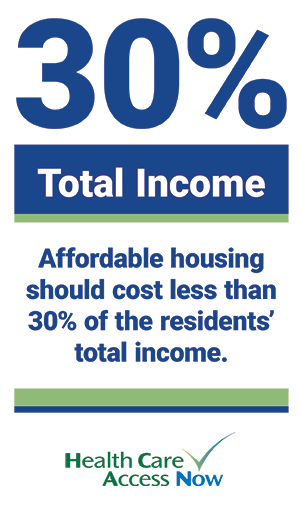Not enough suitable housing in Cincinnati

Health can be affected by many social determinants, including access to affordable housing. If an individual struggles to make rent or mortgage payments, that person likely has limited resources for other necessities that can impact health.
According to the Center for Housing Policy, “Affordable housing alleviates crowding and makes more household resources available to pay for health care and healthy food, which leads to better health outcomes.”
Shortage of suitable housing

The Department of Housing and Urban Development (HUD) defines housing as affordable when it costs less than 30% of the residents’ total income. That includes both rent/mortgage and utility payments. But using 30% as a threshold doesn’t result in the same outcomes across the board. For example, a single mother with children would find 30% more burdensome than someone living alone.
Health Care Access Now (HCAN) trains and dispatches Community Health Workers (CHWs) to go into the field and work with clients to identify and overcome obstacles to good health outcomes. They regularly discover that lack of access to suitable housing is an issue with clients—and have said that there is just not enough suitable housing in Cincinnati.
A recent report from HUD backs up CHWs’ anecdotal evidence: There is a shortage of 19,230 “affordable and available units…for extremely low-income renter households,” as reported by Cincinnati Public Radio.
And, according to a recent HCAN interview with Seth Walsh, Executive Director of the College Hill Community Urban Redevelopment Corporation, a lot of existing so-called affordable housing is of poor quality. He has seen moisture penetration leading to ceiling collapse, lack of heat for long periods of time, rodents and other pests, and extensive plumbing failure, as examples.
What happens now?
Some solutions have been put forth. For example, Issue 3, which failed at the polls in May of this year, would have “require[d] the city [to] put $50 million a year” into the Affordable Housing Trust Fund. And Council Member Chris Seelbach has recently proposed a charter amendment raising income tax by 0.1% for nine years to resulting in $170 million to “provid[e]…a catalyst for private investment,” which Seelbach estimates “will leverage $3 in private dollars to every $1 of public dollars over the duration of the levy,” totaling an estimated $500 million.
One thing is certain: Something needs to be done to rectify this problem. Suitable housing is a necessity for all people. The Cincinnati area cannot achieve health equity without it.






